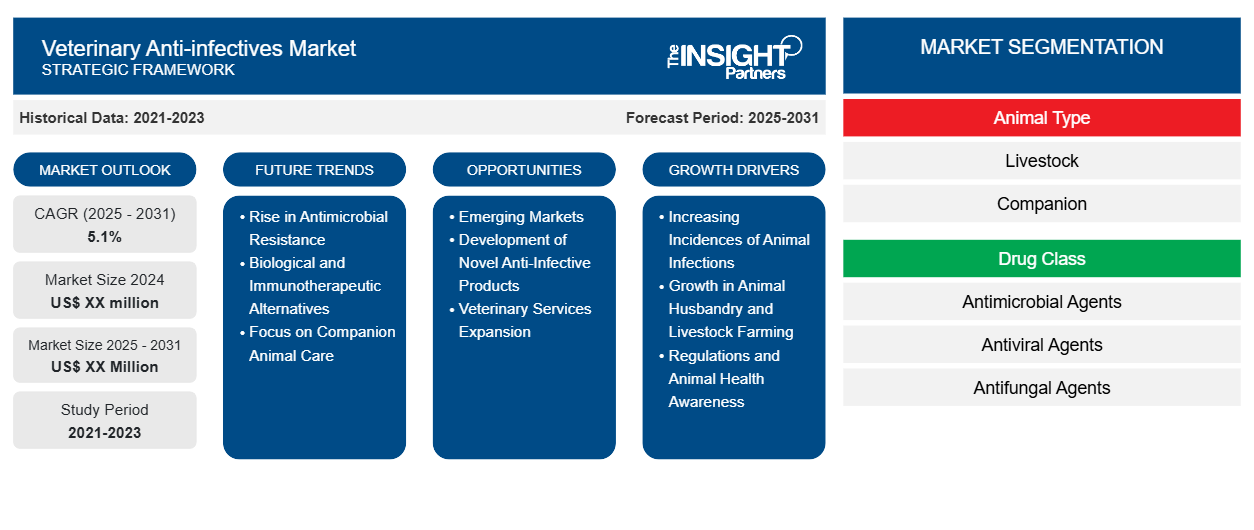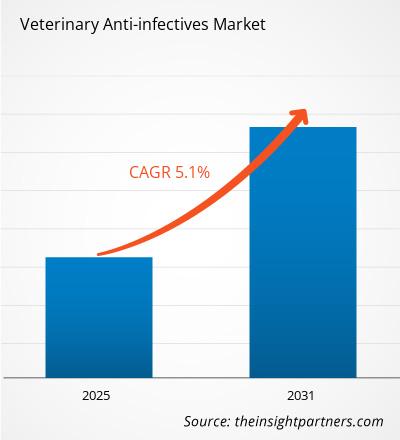The Veterinary Anti-infectives Market is expected to register a CAGR of 5.1% from 2025 to 2031, with a market size expanding from US$ XX million in 2024 to US$ XX Million by 2031.
The report is segmented by Animal Type (Livestock, Companion), By Drug Class (Antimicrobial Agents, Antiviral Agents, Antifungal Agents, Antiparasitic Agents), By Route of Administration (Oral, Parenteral, Topical) By End User (Veterinary Hospitals, Veterinary Clinics, Others)
Purpose of the Report
The report Veterinary Anti-infectives Market by The Insight Partners aims to describe the present landscape and future growth, top driving factors, challenges, and opportunities. This will provide insights to various business stakeholders, such as:
- Technology Providers/Manufacturers: To understand the evolving market dynamics and know the potential growth opportunities, enabling them to make informed strategic decisions.
- Investors: To conduct a comprehensive trend analysis regarding the market growth rate, market financial projections, and opportunities that exist across the value chain.
- Regulatory bodies: To regulate policies and police activities in the market with the aim of minimizing abuse, preserving investor trust and confidence, and upholding the integrity and stability of the market.
Veterinary Anti-infectives Market Segmentation
Animal Type
- Livestock
- Companion
Drug Class
- Antimicrobial Agents
- Antiviral Agents
- Antifungal Agents
- Antiparasitic Agents
Route of Administration
- Oral
- Parenteral
- Topical
End User
- Veterinary Hospitals
- Veterinary Clinics
You will get customization on any report - free of charge - including parts of this report, or country-level analysis, Excel Data pack, as well as avail great offers and discounts for start-ups & universities
Veterinary Anti-infectives Market: Strategic Insights

-
Get Top Key Market Trends of this report.This FREE sample will include data analysis, ranging from market trends to estimates and forecasts.
Veterinary Anti-infectives Market Growth Drivers
- Increasing Incidences of Animal Infections: The rising prevalence of infectious diseases among livestock and companion animals is driving the veterinary anti-infectives market. As the demand for livestock products grows, veterinary anti-infectives are essential for preventing and treating infections in animals, ensuring animal health and safety across the agriculture and veterinary sectors.
- Growth in Animal Husbandry and Livestock Farming: The growing demand for animal-derived products such as milk, meat, and eggs has led to an increase in livestock farming. This growth in animal husbandry creates a need for veterinary anti-infectives to maintain animal health, reduce disease outbreaks, and ensure the quality of animal products, stimulating market growth.
- Regulations and Animal Health Awareness: Increasing awareness about animal health and stringent regulations regarding disease control are contributing to the veterinary anti-infectives market. Government initiatives and regulations to ensure the health and safety of animals are promoting the usage of veterinary anti-infectives, especially in the livestock sector.
Veterinary Anti-infectives Market Future Trends
- Rise in Antimicrobial Resistance: The rise in antimicrobial resistance (AMR) among animals is pushing the demand for alternative anti-infective treatments. As antibiotic resistance becomes a critical concern, there is a shift towards developing new classes of drugs to combat resistant strains, which is driving innovation in the veterinary anti-infective market.
- Biological and Immunotherapeutic Alternatives: The shift towards biological alternatives and immunotherapies is a growing trend in the veterinary anti-infectives market. These treatments are becoming increasingly popular as they provide a more sustainable and effective approach to infection management, reducing the reliance on traditional antibiotics and addressing the issue of resistance.
- Focus on Companion Animal Care: The increasing focus on pet health and companion animals' well-being is a significant trend in the market. As pet ownership continues to rise, especially in developed regions, the demand for veterinary anti-infectives to treat infections and diseases in companion animals is expanding, creating a key market segment.
Veterinary Anti-infectives Market Opportunities
- Emerging Markets: There is a significant growth opportunity in emerging markets, particularly in regions like Asia-Pacific and Latin America. As these regions experience growth in livestock farming and an increase in pet ownership, there is a rising demand for veterinary anti-infectives to address the need for disease management and prevention.
- Development of Novel Anti-Infective Products: There is an opportunity for companies to invest in the development of novel anti-infective products, including vaccines, biological agents, and antimicrobial alternatives. Innovation in this area will help address the growing issue of antibiotic resistance, creating a competitive edge for companies in the veterinary sector.
- Veterinary Services Expansion: The expansion of veterinary services, particularly in rural areas and emerging economies, presents an opportunity for market growth. Improved access to veterinary services and treatments will increase the adoption of anti-infectives, benefiting both livestock and companion animal sectors.
Veterinary Anti-infectives Market Regional Insights
The regional trends and factors influencing the Veterinary Anti-infectives Market throughout the forecast period have been thoroughly explained by the analysts at The Insight Partners. This section also discusses Veterinary Anti-infectives Market segments and geography across North America, Europe, Asia Pacific, Middle East and Africa, and South and Central America.
Veterinary Anti-infectives Market Report Scope
| Report Attribute | Details |
|---|---|
| Market size in 2024 | US$ XX million |
| Market Size by 2031 | US$ XX Million |
| Global CAGR (2025 - 2031) | 5.1% |
| Historical Data | 2021-2023 |
| Forecast period | 2025-2031 |
| Segments Covered |
By Animal Type
|
| Regions and Countries Covered |
North America
|
| Market leaders and key company profiles |
|
Veterinary Anti-infectives Market Players Density: Understanding Its Impact on Business Dynamics
The Veterinary Anti-infectives Market is growing rapidly, driven by increasing end-user demand due to factors such as evolving consumer preferences, technological advancements, and greater awareness of the product's benefits. As demand rises, businesses are expanding their offerings, innovating to meet consumer needs, and capitalizing on emerging trends, which further fuels market growth.

- Get the Veterinary Anti-infectives Market top key players overview
Key Selling Points
- Comprehensive Coverage: The report comprehensively covers the analysis of products, services, types, and end users of the Veterinary Anti-infectives Market, providing a holistic landscape.
- Expert Analysis: The report is compiled based on the in-depth understanding of industry experts and analysts.
- Up-to-date Information: The report assures business relevance due to its coverage of recent information and data trends.
- Customization Options: This report can be customized to cater to specific client requirements and suit the business strategies aptly.
The research report on the Veterinary Anti-infectives Market can, therefore, help spearhead the trail of decoding and understanding the industry scenario and growth prospects. Although there can be a few valid concerns, the overall benefits of this report tend to outweigh the disadvantages.
Frequently Asked Questions
What is driving the veterinary anti-infectives market?
What are the trends in the veterinary anti-infectives market?
What opportunities exist in the veterinary anti-infectives market?
What is the projected CAGR for the veterinary anti-infectives market?
Who are the leading players in the veterinary anti-infectives market?
Which regions are expected to drive the veterinary anti-infectives market?
- Historical Analysis (2 Years), Base Year, Forecast (7 Years) with CAGR
- PEST and SWOT Analysis
- Market Size Value / Volume - Global, Regional, Country
- Industry and Competitive Landscape
- Excel Dataset
Recent Reports
Testimonials
Reason to Buy
- Informed Decision-Making
- Understanding Market Dynamics
- Competitive Analysis
- Identifying Emerging Markets
- Customer Insights
- Market Forecasts
- Risk Mitigation
- Boosting Operational Efficiency
- Strategic Planning
- Investment Justification
- Tracking Industry Innovations
- Aligning with Regulatory Trends






















 Get Free Sample For
Get Free Sample For